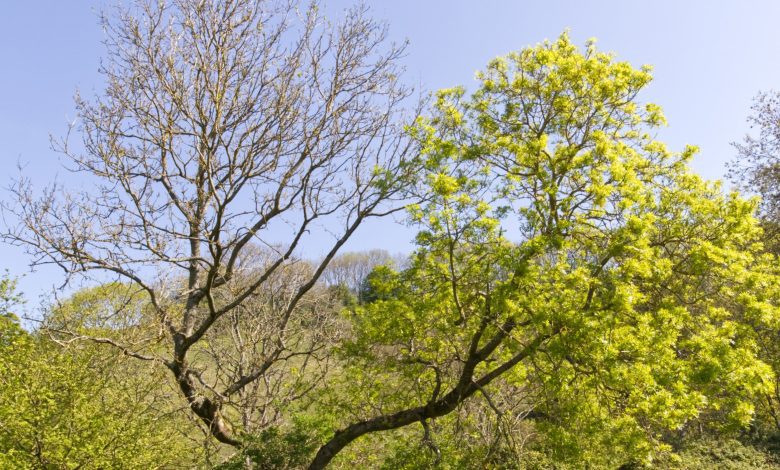The Importance of Understanding and Addressing Ash Dieback

Ash Dieback, scientifically known as Hymenoscyphus fraxineus, is an insidious fungal disease that has become one of the most significant threats to ash trees across Europe and beyond. The gravity of this situation is immense, as it not only endangers the ecological balance but also imperils the cultural, economic, and social landscapes that have been closely intertwined with ash trees for centuries. Understanding and addressing this disease is crucial for preserving these multifaceted aspects of our natural world.
Ecological Significance of Ash Trees
Ash trees (Fraxinus excelsior), one of the most common and widespread tree species in the UK and throughout Europe, play a pivotal role in maintaining the ecological balance within various habitats. These trees are not just individual entities but are integral components of a larger ecosystem, supporting a wide array of wildlife, including birds, mammals, insects, and fungi. Their loss would not be an isolated event but would trigger a cascade of ecological disruptions, leading to significant declines in biodiversity.
Ash trees are known for their unique ability to support a diverse range of species. Their open canopy structure allows light to penetrate to the forest floor, fostering a rich ground flora that includes numerous plant species. This, in turn, supports a variety of insects and other invertebrates, which serve as food sources for birds and mammals. The interconnectedness of these species with ash trees means that the decline of ash populations could result in the collapse of these intricate ecological networks.
In addition to their role in maintaining biodiversity, ash trees contribute to soil health through leaf litter decomposition, nutrient cycling, and providing habitat for mycorrhizal fungi, which are essential for the health of many plant species. The removal of ash trees from these ecosystems would disrupt these processes, potentially leading to soil degradation and reduced fertility, further compounding the ecological impact.
The Threat of Ash Dieback
Ash Dieback, caused by the fungal pathogen Hymenoscyphus fraxineus, was first identified in Europe in the early 1990s, although it is believed to have originated in Asia. The fungus spreads through airborne spores that can travel long distances, infecting trees across vast areas. Once an ash tree is infected, it begins to exhibit symptoms such as leaf wilting, crown dieback, and the development of lesions on the bark. The disease is often fatal, particularly to young trees, while older trees may survive longer but with a significantly reduced lifespan.
The spread of Ash Dieback is alarming both in its speed and its devastating effects. Since its initial identification, the disease has spread rapidly across Europe, leaving a trail of destruction in its wake. In the UK, it is estimated that up to 80% of ash trees could eventually succumb to the disease. This loss would be catastrophic, not only for the natural environment but also for human communities that have historically relied on ash trees for various purposes, including timber, fuel, and as a defining element of the landscape.
The impact of Ash Dieback is not limited to the death of individual trees. The disease also poses a significant threat to entire forests and woodlands where ash trees are a dominant species. The loss of these trees would result in the fragmentation of habitats, reducing their ability to support wildlife and potentially leading to the local extinction of species that depend on ash trees for survival.
Cultural and Economic Impacts
The significance of ash trees extends far beyond their ecological value; they are also deeply embedded in the cultural and economic fabric of many regions. Historically, ash wood has been highly valued for its strength, flexibility, and resistance to splitting, making it an ideal material for a wide range of uses, from crafting tools and furniture to the production of sporting goods such as cricket bats. The loss of ash trees due to Ash Dieback threatens to wipe out traditional crafts and industries that rely on this versatile wood, leading to the disappearance of skills and knowledge that have been passed down through generations.
Moreover, ash trees hold a special place in the cultural identity of many rural communities, particularly in the UK. They are a familiar sight in the British landscape, lining hedgerows, roads, and fields, and their presence is deeply woven into the visual and emotional fabric of the countryside. The widespread loss of ash trees would not only alter the physical appearance of the landscape but could also have profound psychological and emotional impacts on communities that have long valued these trees as part of their heritage.
The economic implications of Ash Dieback are also significant. The cost of managing the disease, including the felling and disposal of diseased trees, is considerable. Local authorities and landowners face substantial financial burdens as they work to remove infected trees to prevent the further spread of the disease and to mitigate the risk of falling trees posing a danger to public safety. The replanting of alternative tree species to replace lost ash trees is another costly endeavour, one that requires careful planning to ensure that new plantings can fulfill the ecological roles that ash trees once played.
In addition to these direct costs, there are also longer-term economic consequences to consider. The loss of ash trees will likely lead to reduced timber supplies, affecting industries that depend on ash wood. The decline of ash-related industries could result in job losses and economic downturns in regions where these industries are a significant source of employment. Furthermore, the loss of ash trees could reduce the appeal of rural areas for tourism, as the character and beauty of the landscape are diminished, leading to further economic challenges.
Expertise in Ash Dieback Management
Given the widespread and devastating effects of Ash Dieback, it is essential to have experts who can guide the management and mitigation of this disease. In Surrey, DG Trees have established themselves as leading experts in Ash Dieback management, offering comprehensive arboricultural services. With extensive experience and a deep understanding of the disease, they provide crucial services in identifying, managing, and mitigating the effects of Ash Dieback in the region.
DG Trees offers a range of arboricultural services tailored to the needs of landowners, local authorities, and other stakeholders. Their expertise includes conducting detailed assessments to identify infected trees, advising on appropriate management strategies, and implementing measures to reduce the spread of the disease. By working with experts like DG Trees, communities in Surrey and beyond can better manage the impacts of Ash Dieback, preserving both the ecological integrity of their landscapes and the cultural heritage associated with ash trees.
Mitigation and Future Challenges
Addressing Ash Dieback requires a multifaceted approach involving research, management strategies, and public engagement. One of the most promising avenues of research is the identification and breeding of ash trees that show resistance to the disease. While some resistant individuals have been identified, developing a population of resistant trees that can be planted on a large scale is a complex and time-consuming process. Nevertheless, this work is essential for the long-term preservation of ash trees in the landscape.
Management strategies to slow the spread of Ash Dieback are also critical. These include the removal of heavily infected trees to reduce the number of spores released into the environment, as well as the careful management of woodlands to promote the health of remaining trees and the regeneration of young saplings. In some cases, it may be necessary to introduce alternative tree species that can fulfill the ecological roles of ash trees, although this approach must be carefully considered to avoid further disruptions to the ecosystem.
Public awareness and involvement are crucial components of any strategy to combat Ash Dieback. Educating the public about the signs of the disease and encouraging the reporting of infected trees can help track its spread and inform management decisions. Additionally, public support is essential for the success of replanting efforts and other conservation initiatives.
Conclusion
Ash Dieback is a stark reminder of the interconnectedness of environmental, cultural, and economic systems. The loss of ash trees would represent a profound shift in the natural and human landscapes of the UK and Europe, with far-reaching consequences for biodiversity, cultural heritage, and local economies. It is imperative that we continue to invest in research, public awareness, and practical measures to mitigate the impact of this disease. By working with experts like DG Trees, who are at the forefront of Ash Dieback management and provide crucial arboricultural services in Surrey, we can take significant steps toward preserving our landscapes and ensuring that future generations inherit a world as rich, diverse, and resilient as the one we enjoy today.





